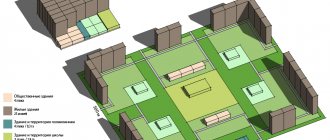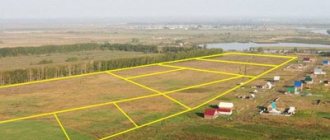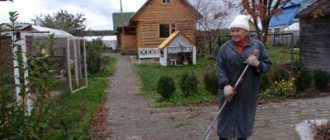Individual residential construction
We are talking about land areas intended for private individuals. Signs enshrined in the law:
- Purpose - for the construction of a residential cottage or country house.
- Single-family cottage (not multi-family).
- The maximum permitted height is no more than three floors.
- The building is separate, not combined with others.
An additional allocated plot of land is permitted for land use:
- Farming (farm) - breeding animals, growing crops for the purpose of generating income.
- Personal subsidiary plot (PHS) - used to feed the family.
- Gardening – growing fruit trees and shrubs, berries, etc.
- Vegetable gardening is plant growing on a non-industrial scale, for use by one family.
In this case, a plot with a cottage and outbuildings owned by citizens may be located:
- Within the city limits.
- Outside the city limits (suburbs).
- In the countryside.
The legislative requirement for land plots to comply with minimum and maximum sizes is aimed primarily at ensuring the rational use of land plots and seems quite logical, since in the absence of such restrictions it would be possible to endlessly divide land plots, as a result of which so-called micro-plots could appear, unsuitable for full use.
As a rule, the appearance of land plots with an excessively large area also does not contribute to their rational use. It is this circumstance that is one of the main reasons for the legislator to apply restrictions related to the maximum size of land plots. Owners of land plots often need to divide them. A study of judicial practice has shown that the main reasons for the division of land plots are: - division of property between heirs; - division of property between former spouses; — the desire of one of the co-owners to allocate his share with subsequent sale; - the owner’s desire to sell or donate not the entire land plot, but only part of it. Dividing a land plot into parts whose size is less than the established minimum size of a land plot is not allowed. Accordingly, a land plot, the division of which into parts that meet the minimum requirements for the size of land plots is impossible, is indivisible. Currently, the legislation regulating the maximum size of land plots has undergone significant changes. Thus, from March 1, 2015, paragraph 4 of Art. 41 of the Town Planning Code of the Russian Federation, which stated that when dividing a land plot into several plots, the sizes of the formed land plots should not exceed the maximum sizes of land plots provided for by the town planning regulations and should not be less than the minimum sizes of land plots provided for by the town planning regulations. Meanwhile, the requirement for the maximum size of the land plots to be formed to comply with urban planning regulations is still contained in paragraph 1 of Art. 11.9 Land Code of the Russian Federation. In addition, Art. 33 of the Land Code of the Russian Federation, according to which the minimum and maximum sizes of land plots provided to citizens for running peasant (farm) farming, gardening, truck farming, livestock farming and dacha construction were established by the laws of the constituent entities of the Russian Federation, and for running personal subsidiary plots and individual housing construction - by regulations legal acts of local governments. Apparently, by making these changes to the legislation regulating the maximum size of land plots, the legislator aimed to simplify legal regulation in this area, as well as eliminate duplication of provisions contained in a number of legal norms. So, for example, clause 4 of Art. 41 of the Civil Code of the Russian Federation in its semantic content did not differ much from paragraph 1 of Art. 11.9 Land Code of the Russian Federation. Another reason for the transformations that have taken place is an attempt to eliminate contradictions associated with the application of legislation on the minimum size of land plots provided for the ownership of citizens from lands in state and municipal ownership to other relations not related to the provision of land plots. Today, according to paragraph 1 of Art. 11.9 of the Land Code of the Russian Federation, the maximum and minimum sizes of land plots in respect of which, in accordance with the legislation on urban planning activities, urban planning regulations are established, are determined by such urban planning regulations. Urban planning regulations are contained in the rules of land use and development of municipalities and are approved by the representative body of local government. Land use and development rules are the basis for urban zoning and determining the legal regime of land in settlements, since they establish the types of permitted use of land plots, maximum (minimum and (or) maximum) sizes of land plots and corresponding restrictions on their use. Town planning regulations often contain reference norms that point to other municipal legal acts that establish maximum sizes of land plots. Being municipal legal acts, town planning regulations extend their effect only to the territory of the corresponding locality. In accordance with paragraph 2 of Art. 11.9 of the Land Code of the Russian Federation, the maximum (maximum and minimum) sizes of land plots to which town planning regulations do not apply or in respect of which town planning regulations are not established are determined in accordance with the Land Code of the Russian Federation and other federal laws. In this regard, the question quite naturally arises related to the definition of land plots to which the action of town planning regulations does not apply or in respect of which town planning regulations are not established. Based on Art. 36 of the Civil Code of the Russian Federation, the effect of the town planning regulations does not apply to land plots: - within the boundaries of the territories of monuments and ensembles included in the unified state register of cultural heritage sites (historical and cultural monuments) of the peoples of the Russian Federation, as well as within the boundaries of the territories of monuments or ensembles that are identified objects of cultural heritage and decisions on the maintenance regime, parameters of restoration, conservation, reconstruction, repair and adaptation of which are made in the manner established by the legislation of the Russian Federation on the protection of cultural heritage objects; — within the boundaries of public areas; — intended for the placement of linear objects and (or) occupied by linear objects; - provided for mining. Urban planning regulations are not established for forest lands, lands covered by surface water, reserve lands, lands of specially protected natural areas, agricultural lands as part of agricultural lands, land plots located within the boundaries of special economic zones and territories of priority socio-economic development. The minimum and maximum sizes of land plots for which, in accordance with Art. 36 of the Civil Code of the Russian Federation, the effect of urban planning regulations does not apply, or in respect of which such regulations are not established, they are determined in accordance with the Land Code of the Russian Federation and other federal laws. Other federal laws include the Federal Law “On Personal Subsistence Farming” and the Federal Law “On the Turnover of Agricultural Land,” which, together with the Land Code of the Russian Federation, very poorly regulate relations related to the maximum size of land plots. V.L. draws attention to this circumstance. Belyaev, saying that such laws either do not exist or regulate these issues extremely weakly, which in practice complicates the development of territories. So, according to Art. 4 Federal Law of July 7, 2003 No. 112-FZ “On personal subsidiary plots”, the maximum and minimum sizes of land plots provided to citizens from state or municipally owned lands for running personal subsidiary plots are established by regulatory legal acts of local authorities self-government. The maximum size of the total area of land plots that can be simultaneously owned and (or) otherwise owned by citizens running personal subsidiary plots is set at 0.5 hectares. The maximum size of the total area of land plots may be increased by law of the constituent entity of the Russian Federation, but not more than five times. (Federal Law of July 7, 2003 No. 112-FZ “On personal subsidiary farming” (Rossiyskaya Gazeta. 2003. No. 135)). In accordance with Art. 4 Federal Law of July 24, 2002 No. 101-FZ “On the turnover of agricultural land”, the minimum sizes of new land plots formed from agricultural land can be established by the laws of the constituent entities of the Russian Federation in accordance with the requirements of land legislation. Federal Law of July 24, 2002 No. 101-FZ “On the turnover of agricultural land” (Rossiyskaya Gazeta 2002 No. 137). The rights registration authority makes a decision to refuse to register a land plot if the size of the land plot being formed or the land plot that, as a result of the transformation, remains within the changed boundaries (changed land plot) does not comply with the requirements established in accordance with federal law. maximum (minimum or maximum) sizes of land plots (Federal Law of July 13, 2015 No. 218-FZ “On State Registration of Real Estate”) Taking into account and using the stated provisions in legislative activity will improve the efficiency of legal regulation of land relations, and will also help reduce the number land disputes.
Where does the definition of maximum permissible values not apply?
The considered minimum and maximum standards do not apply to the following cases:
- Acquisition for a fee of territory that is under the jurisdiction of the state or municipality.
- Planning and construction of institutions and enterprises of federal or local significance.
In this case, the following locations are allowed on the site:
- Roads for traffic – private, regional, federal.
- Heating facilities, either supplying water, electricity, and belonging to a subject of the federation.
Legal acts
The minimum and maximum area of a land plot is established by legislative acts at the federal level:
- Land Code of the Russian Federation – Article 11.9.
- Town Planning Code of the Russian Federation - Article 30, part 6, paragraph 1.
- State Law “Technical Regulations on Fire Safety Requirements”, number 123.
- Federal Law No. 112 “On personal subsidiary plots”.
- Federal Law “On Peasant Farming”, number 74.
- Building regulations.
The purpose of regulating the size - why citizens cannot get as much land as they want - is to make its use optimal and useful to the maximum. Codes are the first authority that provides general requirements for decisions made at the regional level.
The final point where allotment parameters are set is the municipality of a particular area. He issues regulations where the numbers are clearly stated. The local administration uses urban planning regulations and “Land Use and Development Rules” in its work.
In practice, the legislation uses the following procedure:
- Acts of the Government of the country regulate legal relations related to lands belonging to the federation.
- Regional regulatory documents concern benefits that apply to individual construction.
- Resolutions of local administrative bodies apply to individual housing construction in general.
The rule that must be observed in the second and third cases is the absence of contradictions between federal laws and acts of municipalities.
Maximum maximum sizes of land plots in the Moscow region
As mentioned above, the maximum maximum sizes of land plots are established by legislative acts at several levels (depending on who owns the land).
Town planning regulations approved by local authorities must regulate all elements of the development of a settlement, down to the appearance of a particular building and its construction on a particular street.
Each of these regulations should not contradict all laws at the federal level, but first of all, it should not contradict the norms of the Town Planning Code of the Russian Federation.
In the Moscow region, on June 17, 2003, the law “On the maximum size of land plots provided to citizens as property in the territory of the Moscow region” was adopted.
This regulatory legal act establishes the following standards for maximum plot sizes:
| Type of permitted use | Possible maximum size in acres |
| Farming | 4000 |
| Gardening | 15 |
| Horticulture | 10 |
| Country construction | 25 |
At the municipal level, local acts were also adopted establishing the maximum size of land plots for each district of the Moscow region.
How are the maximum land sizes set?
As a result, the size of the land for individual housing construction is determined by the regional administration. Factors that are taken into account when regulating the boundaries of development plots:
- The size of the territory of a subject of the Federation that is not yet occupied by residential buildings and household plots.
- The total number of applications submitted to territorial authorities by citizens applying for registration and construction in the area.
- The state of the economy and social sphere in the region (including the number of inhabitants per square meter of the total territory of the subject).
- Composition of the applicant’s family (how many minor children, elderly persons in care, etc.).
- The purpose of use is a farm or private household plot, as far as this is promising.
- Features of the building project.
Thus, cities of federal significance with dense buildings (Moscow, St. Petersburg) are not subjects where you can get plots for individual housing construction - it is easier to buy an apartment here. On the contrary, in rural areas of the Moscow and Leningrad regions it is quite possible to acquire plots for personal subsidiary plots, the sizes of which vary widely.
Size of land plot in 2021: number of acres for a house
The maximum and minimum sizes of land plots in cities and towns are established by the state.
Minimum plot area
The minimum is three hundred square meters. In the event that a family plans to purchase a smaller plot, it will not be registered in Rosreestr as an object for individual housing construction. Likewise, the relevant authorities will not issue a permit for the construction of a house or cottage. This should be taken into account at the stage of selecting land for future development.
Some regions set a much higher figure - six hundred square meters (Leningrad region, Novosibirsk, etc.). In the Moscow region, Yekaterinburg and Krasnodar region the value is four.
Maximum land area
The standards may vary at most, depending on the conditions in a particular region. The average is thirty acres. The exact figures must be clarified with the administration of the region where it is planned to allocate the property. Even if you manage to obtain a large territory, it will no longer be possible to register it.
Minimum values also vary greatly:
- St. Petersburg - 15 hundred, Leningrad region. – 25 hundred.
- Moscow - not issued, Moscow region - 30 hundred.
- Novosibirsk and Krasnodar - 10 hundred.
- Ekaterinburg - 25 hundred.
How and where to get accurate information?
Details can be found in the form of a consultation:
- In person at an appointment at the local cadastral service.
- by phone - call the administration hotline.
- On the website of local authorities - the data is published under the meaning of “land use and development parameters”. To find them, you need to find general rules regarding individual housing construction.
In any of the three cases, it is necessary to indicate that zone G1 is of interest, i.e. allotment for a cottage with a small number of floors and personal use. It is also important to take into account that all of the specified space restrictions apply to the free acquisition of real estate. The problem can be solved by purchasing an object.
Minimum plot size for other needs (not individual housing construction)
The procedure for determining the minimum territory for plots of other purposes will be different. The question concerns farming activities and dacha areas. This is also indicated in the regulatory documents of a particular subject of Russia. For example, data for St. Petersburg and the Leningrad region:
- For a garden - from 200 sq. m to 0.05 hectares.
- For a vegetable garden - from 200 sq. m to 0.1 hectare.
- For animal breeding – from 0.01 to 5 hectares.
- For the construction of a garage - 18 square meters. m.
- Farm - from one to 50 hectares.
The average minimum for the country is 6 acres, the maximum is 0.15 hectares. The limits are reduced depending on what areas the municipality as a whole has and whether there is a shortage.
The general requirement for land for agriculture is no more than 10 percent of the total territory owned by the municipality.
Maximum limit size
This expression includes several concepts, this is not only the area of the plot itself, but also the regulatory setbacks of buildings from the boundaries of the plot, the maximum percentage of development within the boundaries of the land plot, and the permitted number of floors.
Such norms are specified in urban planning regulations established in each locality by local authorities. To find out what established standards apply in your city or town, you need to contact the authorities, the municipality.
In different regions, the maximum and minimum sizes of land allocated for individual construction differ. But the average number of acres allocated for a house is 3. The number is small, but you need to check with the authorities dealing with land issues, perhaps you can get a more spacious area.
When allocating a plot of land for individual housing construction, its new owner may encounter a number of problems, in particular, conflicts that sometimes arise with neighbors and owners of adjacent plots.
If you know the rights of the owner and the rules by which land is allocated, the established maximum size of the plot for building a house is determined, the conflict will quickly be resolved.
Territorial zones for non-profit, religious entities
Basic rules regarding boundaries and development:
- The distance from the building to the border is three meters. In practice, the rule is advisory in nature, because Some already built temples (we are talking about reconstruction) are located on the edge of the territory.
- The maximum area should not be built up to more than 80 percent.
- Construction of up to two floors is permitted.
- You can make an extension.
It is permissible to use the temple courtyard for:
- Residential building for employees.
- Utility rooms.
- Hotel for pilgrims.
- Retail outlet.
- Planting trees and shrubs.
Applying for a land plot: how not to be refused?
In order to avoid mistakes and save time on registration procedures, you must:
- Study the urban planning regulations: find materials on specific land plot sizes.
- Familiarize yourself with the laws relating to individual housing construction in a given region and clarify the basic requirements.
- Submit an application to your local surveyor's office. Specialists will draw up a land surveying plan with precise indications of the boundaries of the plot.
Construction work can begin only after the registration procedure with the cadastral service - a passport will be received for the piece of land.
Documents required to allocate land ownership:
- Russian passport and TIN certificate.
- Passport from the cadastral service.
- Land survey plan.
- A receipt confirming payment of the state duty.
Redistribution of an existing site
The procedure is regulated by the Land Code of the Russian Federation - Article 39. This applies to both private and municipal property.
In this case, limiting rules are established:
- A general agreement between the owners to change the existing boundaries of the allotment is mandatory.
- Kinking, wedging and placing one section on another is not allowed.
- The territory can only be increased to the maximum allowed in the region.
After an agreement has been concluded, the land surveying procedure is mandatory - after this, an act and a diagram of the new boundaries are drawn up, and the participants are issued new cadastral passports.
Conditions for combining land plots
The legislation specifically stipulates the requirements for initial sites, in particular:
- in addition to their contiguity, boundaries should be established in accordance with government regulations;
- In these territories, characteristic points must be fixed with due accuracy. If it turns out that the accuracy is lower than required by the standards, it will be necessary to further clarify the boundary points of such a section;
- The merged plots must belong to the same land category. In some cases, when the owner of a new plot will choose the type of its use, this rule may be violated;
- the initial sites must be geographically located in the same locality (municipal entity);
- if it is planned to unite land plots that are provided for indefinite use, inherited for lifelong ownership or are in urgent free use, they must have one legal holder;
- when merging plots, the permissibility of using the real estate located on them must be maintained;
- the formation of new plots should not cause disadvantages in the area that impede the protection of lands and their rational use: wedging and interspersing, brokenness and striping, and also violate the requirements,
- established in the Land Code of Russia and federal legislation.
In addition, the legislation separately stipulates the requirements for the maximum limit of land size, which must be observed for new territories.







